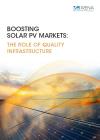

-
-
IRENA (2017), Boosting Solar PV Markets: The Role of Quality Infrastructure, International Renewable Energy Agency, Abu Dhab
Copied
/-/media/Files/IRENA/Agency/Publication/2017/Sep/IRENA_Solar_PV_Markets_Report_2017.pdf
Copied
Boosting solar PV markets: The role of quality infrastructure
Newsletter
As solar photovoltaic (PV) power systems become increasingly competitive, continued market growth depends on assurances of performance and durability. Quality assurance protects and accelerates future PV investments, lowers capital costs, improves performance, extends module lifespans and lowers the resulting electricity costs.
From less than 10 gigawatts (GW) worldwide in 2006, installed solar PV capacity reached nearly 300 GW in 2016. More than 71 GW was added in 2016, with over USD 113 billion invested in solar energy technologies.
However, comprehensive quality assurance requires physical and institutional infrastructure. This so-called, Quality Infrastructure (QI), comprises the total institutional network and legal framework that formulates and implements standards. It also includes testing, certification, metrology and accreditation.
This handbook from the International Renewable Energy Agency (IRENA) outlines the best practices to develop and implement QI for solar PV. The data and analysis provides:
- Guidance for establishing proper QI mechanisms, showcased through successful experiences with utility-scale, distributed-generation and off-grid PV development in 11 countries;
- Five case studies offering quantified cost-benefit analysis for QI implementation at different stages of PV plant development.
The benefits achieved are consistently seen to outweigh the costs of QI implementation. Independent quality testing under engineering, procurement and construction (EPC) contracts can boost PV system performance by 2−3%, one case study shows.
QI implementation can be incremental, reflecting country context and PV market maturity. Yet QI remains essential along the entire value chain to create robust PV markets and build up confidence among investors, policy makers and consumers. The resulting quality assurance helps make PV systems affordable and reliable, as well as environmentally sustainable and economically viable.
View the Executive Summary for Policy Makers
Also see these earlier Quality Infrastructure for Renewable Energy Technologies handbooks (IRENA, 2015):




